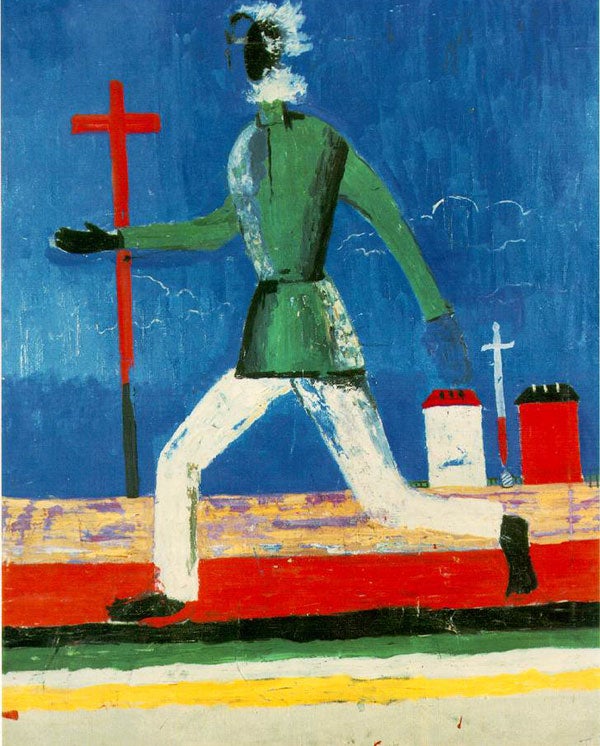Great Works: Running Man (circa 1932), Kasimir Malevich
Musee National d'Art Moderne, Paris

Human beings are like many things. But the most persuasive likenesses are often the ones in which humans are likened to things that look human. The difference is usually relatively small: scarecrow, suit of clothes, puppet, mannequin, robot, statue, ghost, angel, ape, god, alien, cartoon character. But while these things are all based on the human model, their repertoire is wide. They offer extreme variants, in terms of what they are made of, or how they are shaped, or what they can do.
In art, this human likeness-repertoire expanded enormously in the 20th century. Before that, images of humans generally looked quite closely like humans. True, there were some extreme, idealising versions. The will-powered muscleman of the Michelangelesque figure, super-hero-going-on-god, was one. The lithe, pneumatic, sinuous human fillet, the beauty queen according to Ingres, was another. There were not many such variations.
In early modern art, things and bodies changed. These creatures range through many imaginary species. There are immaterial spirits. There are solid and invulnerable dolls. There are cleanly operating machine men. There are blobs of pure and uncontrollable flesh.
And though words like "deperson-alisation" and "distortion" have been used, the intention of these variations – as in the past – has usually been some kind of idealisation. There is perfection in dolls. There is grace in machines. There is freedom in meltdown.
Kasimir Malevich, having pioneered a language of abstraction, went on to generate a variety of new humanoids. He made curved, milled, metallic figures and flat, half-abstract figures like standing costume designs. Sometimes a figure is a bobbin, straight at attention. Sometimes there are standing ghosts. Then there is the Running Man.
The Running Man is given a story. The subject of the painting is often taken to be the murderous persecution of peasants by the Soviet government. Its mood is panic, desolation. (An alternative title is Feeling of Fear.) The man is racing across strips of ground. Abstract symbols abut him: two houses of red and white, between them the bloodied sword of violence. His face and hands are blackened. He flees towards or past a tall cross which is burnt, rotten.
This is all quite likely. But we should not gauge a picture just by its subject or its symbols. A figure has its own gist. If we look at the man in the Running Man – at its form, its action – we find another sense, less fearful. This is a light figure, light-footed. It does not make firm contact with the ground. It is not under gravity. It is held up mid-air, supported from above, as if by invisible strings. Or it is held up in mid-picture, supported simply by the fact that it is an image painted on a canvas.
It is a human form without weight. It is also a human anatomy without its leadership structure. A normal body has a nerve centre: the head is in command, the limbs its strenuous instruments. With the Running Man, the action is spread out, distributed equally throughout the figure. There is no trying. The body acts without strain.
But it still has energy. It is not a pinned-down pattern or a static diagram. It floats within the pictorial field but in its outflung limbs it has a wild, free momentum. At the same time, its head and torso stay quite upright, right in the middle of the picture, maintaining the figure's equilibrium.
So within this image of terror, there is another ideal model of the human: weightless, strainless, flying, balanced. It shows a lifeform delivered from all pressures or inertia, external or internal – a scarecrow-marionette-immortal.
About the artist
Kasimir Malevich (1878-1935) made the great reduction. In 1914 he painted 'Suprematist Black Square', a plain black square within a white margin. A series of pure geometrical abstractions followed, battlefields of multi-coloured shapes. The revolution in Russian art coincided with the political revolution, and for a while they worked in tandem. Then state policy demanded more accessible art. Malevich's response to his danger is inscrutable. He returned to various forms of half-figuration – humans, houses and landscapes – whose mood is mysterious. He probably escaped Stalin through an earlyish death. "No phenomenon is mortal," he wrote.
Join our commenting forum
Join thought-provoking conversations, follow other Independent readers and see their replies
Comments
Bookmark popover
Removed from bookmarks